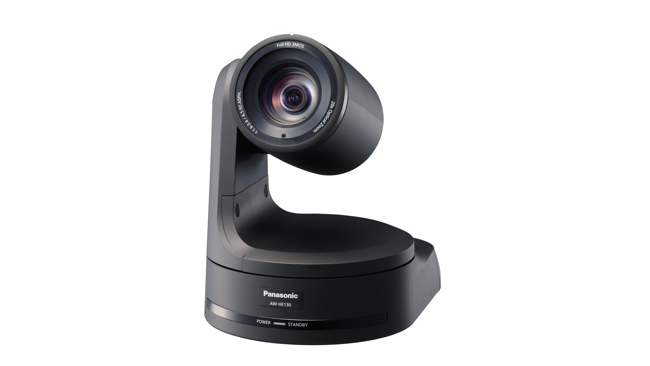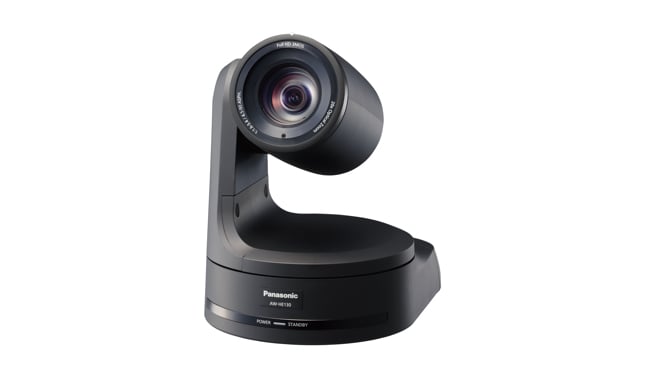
 The Panasonic AW-HE130BK features the same 3 chip sensor as some P2 camcorders
The Panasonic AW-HE130BK features the same 3 chip sensor as some P2 camcorders
PTZ cameras have grown up. Today, they’re capable of broadcast quality and are ideal for cost-effective, space-conscious studios and a wide range of other applications. They’re certainly not to be confused with security cameras.
In the last few years, PTZ (Pan, Tilt and Zoom) cameras have become more powerful - and versatile. The latest cameras are full broadcast quality (up to 4K) and have such comprehensive connectivity that there's usually no need for a conventional broadcast infrastructure.
This is ideal for modern video productions in an environment where broadcast infrastructure is rapidly being replaced by IP/IT technology.
At the same time, demand for video content is mushrooming beyond the capacity of traditional budgets. This calls for more TV production facilities but without the cost.
Here's how PTZ cameras can help.
Use PTZ cameras in place of conventional cameras
Now that PTZ cameras have broadcast quality specifications, they can be used anywhere that a conventional TV camera would have been found. They take up very little room, and can even be ceiling-mounted. You don't need to allow room for camera operators.
It’s worth taking a minute to look at how Panasonic Professional PTZ cameras differ from the familiar security devices that we see all around us.
Image Quality
The Panasonic PTZ camera range includes models that are capable of broadcast quality and beyond. Sensitivity, resolution, noise level and the level of adjustment can be compared to most broadcast cameras.
Smooth Pan/Tilt/Zoom (PTZ)
Panasonic PTZ cameras are engineered to provide moves that look as good, if not better, than a conventional manual camera. Smoothness is built in and camera moves are controllable through automation and repeatable with precision. The cameras are designed with the assumption that they will be used on-air.
Comprehensive interfaces for system installers
Panasonic PTZ cameras have a wealth of interfaces: 3G SDI, HDMI, Serial, IP, NDI support and PoE+ for video, control and power.
Remote control
PTZ cameras can be remote controlled via Network, Serial, Infra Red and other third party protocols.
Let’s have a look at some of these aspects in more detail.
Quality and convenience
Now that PTZ cameras have broadcast quality specifications, they can be used anywhere that a conventional TV camera would have been found. They take up very little room, and can be ceiling or desktop mounted, in a jib, truss, or even completely hidden.
As an example, the AW-HE130 uses the same broadcast quality 3 chip sensor as some P2 camcorders, allowing for colour accuracy, resolution image quality that complies to broadcast requirements
PTZ cameras will slot into an existing SDI studio. For those already thinking in video over IP technology, Panasonic is now supporting NDI from NewTek. NDI can send eight or more HD video signals over a single gigabit network connection.
Produce more content
PTZ cameras are remote-controlled. As their name suggests, they can be zoomed, tilted and zoomed from anywhere with a network or serial connection. This can be in real-time, or as a set of consistent, pre-programmed moves. It means that once a studio is set up, it can effectively operate by itself, with just the presenter and an operator/director - somewhere - remotely.
While this means that fewer people are needed to run a studio, it also means that the same number of staff can be used to run more small studios, and produce more content, which is exactly what's needed to supply today's insatiable demand for content.
Panasonic has a uniquely flexible variety of controllers and auto-tracking software, as well as third party control via open protocol/APIs.
The potential and power of a network
Panasonic recently announced that it is supporting NewTek's NDI network technology several of its PTZ cameras.
NDI allows bidirectional video to be carried over standard IT networks, connecting cameras, switchers and other video devices together, without any need for hardware routing. NewTek’s TriCaster live production systems support PTZ cameras directly, and it’s even possible to set up camera moves in advance and switch between a set of pre-arranged camera moves.
Education
PTZ cameras are ideal for capturing lectures. Small lectures can be recorded with a single camera. Bigger presentations might call for multiple cameras. Content can be recorded remotely or in the camera itself and it’s perfectly feasible to set up campus-wide or even multi-campus centrally-controlled systems. Students can watch live or later, on-demand. Cameras can be operated through a variety of control ecosystems including Crestron, AMX and Extron, or through a more intuitive way by tapping over the picture on an iPad. And thanks to the Autotracking function, the teacher can be tracked constantly.
Medical
Video is essential for training surgeons and other medical practitioners. It's impractical to have conventional cameras in operating rooms: they're hard to sterilise and they (and their operators) get in the way. You can't take risks in these circumstances. With PTZ cameras in an operating room, it would be possible to stage a multi-camera production without any personnel in the operating room. The images can be carried over a secure network to one or more lecture theatres for viewing by students.
Sports
Put PTZ cameras in difficult locations on the field. Fill in additional angles that are not covered by conventional cameras. Keep them out of harms way and control them remotely. Panasonic has outdoor enclosures for protecting PTZ cameras against the elements.
Reality TV
PTZ cameras can't be beaten for round the clock remote operation. They have fantastic image quality and don't get in the way. Some have extremely powerful zoom lenses. And thanks to the Night Mode, cameras can deliver good black-and-white images in the darkness. They're essential kit for any serious Reality show.
Panasonic now has an incredible line-up of PTZ cameras with a vast range of connectivity options. Completely unobtrusive, they can be installed practically anywhere, remotely controlled, and via Powered over Ethernet Plus (POE+) deliver power, IP control and video with embedded audio over a single Cat 5/6 cable.
House of Worship
PTZ cameras are perfectly suited to video production in places of worship. These often large buildings can be difficult to install and manage with conventional cameras. Panasonic PTZ cameras can be placed virtually anywhere for image magnification, live streaming, for video distribution to multiple campuses and more.
To learn more about the Panasonic PTZ camera family, visit (US) and (Europe)
Tags: Production


Comments